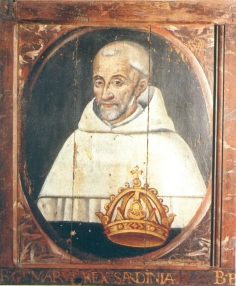Æthelberht was King of Kent from about 589 until his death. The eighth-century monk Bede, in his Ecclesiastical History of the English People, lists him as the third king to hold imperium over other Anglo-Saxon kingdoms. In the late ninth century Anglo-Saxon Chronicle, he is referred to as a bretwalda, or "Britain-ruler". He was the first English king to convert to Christianity.

Penda was a 7th-century King of Mercia, the Anglo-Saxon kingdom in what is today the English Midlands. A pagan at a time when Christianity was taking hold in many of the Anglo-Saxon kingdoms, Penda took over the Severn Valley in 628 following the Battle of Cirencester before participating in the defeat of the powerful Northumbrian king Edwin at the Battle of Hatfield Chase in 633.

William I, regnal name Salusio IV, was the Giudice of Cagliari, or high Judge, from 1188 to his death. His descendents and those of his immediate competitors intermarried to form the backbone of the Italian Aristocracy, and ultimately their descendents in the Medici clan are precursors to, and definers of later royalty and claims thereto.

Gonario II was the giudice of Logudoro from the death of his father to his own abdication in 1154. He was a son of Constantine I and Marcusa de Gunale. He was born between 1113 and 1114 according to later sources and the Camaldolese church of S. Trinità di Saccargia was founded in his name by his parents on 16 December 1112, though it wasn't consecrated until 5 October 1116.
Constantine III, possibly a son of Ittocorre, succeeded Comita Spanu as giudice of Gallura in 1146 and reigned until 1161, when he retired from the world as a monk. He was the first Gallurese ruler of the Lacon dynasty and was characterised by "nobility of mind."
Constantine I was the giudice of Cagliari. He was the son of the giudice Orzocco Torchitorio and giudicessa Vera. In the eleventh century, the throne of Cagliari traditionally passed between the houses of Torchitorio de Ugunale and Salusio de Lacon. Constantine took the name Salusio II upon his succession, in an attempt to unite the families. He appears in contemporary charters as rex et iudex Caralitanus: "King and Judge of Cagliari."
Constantine II was the giudice of Cagliari. He was called de Pluminus after his capital city.

The Judicate of Cagliari was one of the four Sardinian judicates of the Middle Ages, kingdoms of Byzantine origins.

The kings or judges of Cagliari were the local rulers of the south of Sardinia during the Middle Ages. Theirs was the largest kingdom and for the eleventh through twelfth centuries contested the supremacy on the island with that of Logudoro. It was often an ally of the Republic of Pisa and an early supporter of Western monasticism.

The Judicate of Gallura was one of four Sardinian judicates in the Middle Ages. These were independent states whose rulers bore the title iudex, judge. Gallura, a name which comes from gallus, meaning rooster (cock), was subdivided into ten curatoriae governed by curatores under the judge. In the 13th century, the arms of Gallura contained a rooster.

Orzocorre Torchitorio I was the Judge of Cagliari from about 1058 to his death. At his time, the throne was customarily alternated between the Torchitorio de Ugunale and Salusio de Lacon families. Obviously, Torchitorio was of the former.
Barisone II Torchitorio IV de Serra was the Judike (Judge) of Arborea and Cagliari.
William II Salusio V was the Judge of Cagliari from 1232 to his death. His Christian name was William, but his regnal name was Salusio, based on ancient Cagliaritan traditions which alternated their rulers between the forenames Torchitorio and Salusio. He would have been called Salusio in official documents, though he is known historically as William, after his grandfather, William I.
Ittocorre Gambella was the regent of the Giudicato of Logudoro between 1127 and sometime before 1140.

Torchitorio de Zori is the earliest Judge of Gallura known with certainty and attested by contemporary sources. He lived in the late 11th century at a time when Sardinia was entering the wider Western European scene for the first time in centuries. Like his contemporary judges, he patronised Western monasticism.
Torchitorio II, also known by his birth name as Marianus II and surnamed de Unali, was the Judge of Cagliari from circa 1102 to his death, but initially with opposition.
Orzocorre I was the Judge of Arborea from circa 1070 to circa 1100 and is the first ruler of Arborea about whom anything substantial is known. He was the founder of an Arborean dynasty which reigned until 1185. He succeeded Marianus I, about whose government nothing is known, though some presume that Orzocorre was his son. If true, this would make Orzocorre a member of the Thori family.

Andrew Tanca was an obscure Judge of Logudoro in the mid-eleventh century. He may have reigned alongside his supposed father Barisone I between about 1064/1065 and 1073 or so. He was probably the father of his probable successor, Marianus I. Little else is known for certain about him, but he was probably a donor to the Abbey of Montecassino.
Torbeno or Turbino was briefly Judge of Cagliari after Constantine I for an unknown period between 1090, when Constantine last appears in the sources, and 1108, when Constantine's son Torchitorio II first appears as judge.






